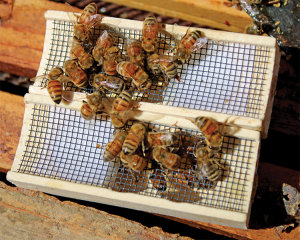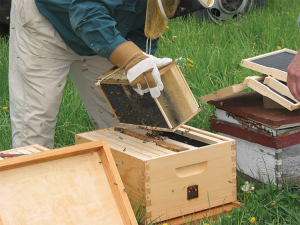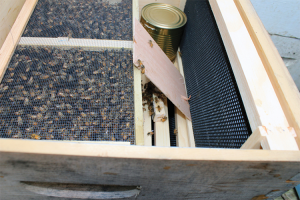The angst of making package bee decisions. Guessing and fretting.
By: James Tew
Guessing about buying packages
Guessing at upcoming package needs is primarily an issue for established beekeepers who are trying to maintain colony numbers or even grow their colony numbers. For some of you, the planning and guessing began as long ago as last November, but I put off making my package decision until mid-February, 2018. At some point most of us must guess about how many packages we will need for the upcoming Spring. Estimate might be a better word to use here. The Winter of 2018 in Ohio was truly cold. In fact, it was truly cold in many states – even southern states.
Bees can withstand cold if given food and shelter, but as we all know, our bee stock has not been healthy for the past decade or so. Our Winter losses have soared. We must guess – often with limited information – at how many more will die before Spring. Packages and queens are expensive. We need to guess right.
Once the packages arrive, then we must begin to guess about the weather and installation procedure. It seems to never end.
“Google” it
Go ahead, Google “Package Bee Installation” and you will get a crazy number of hits. One of the many segments that I randomly reviewed reported that one could learn to install a package by watching a two minute video. Across the internet, beekeepers are bouncing and shaking 3# packages into awaiting equipment. How difficult could it be? If you spend two-three minutes per hit, there are enough videos and instructions to keep one reading for a short four years. In general, releasing the bees is a simple process, but there are a couple of variations.
The Traditional Five-Step Process
In general, installing package bees is about a five step process. (1) Remove the outer lid and feeder can, (2) Remove the queen cage and check her out, (3) remove the cork from the candy plug end and insert – end-up – between frames in the colony, (4) Bounce and shake bees on the queen cage. (5) Place the empty cage in front of the hive and close things up. Yes, I know there are all kinds of variations on this general procedure but this is the typical way. Then return in a few days (seven days or longer?) to be sure the queen is out and – ideally – laying eggs. Have some kind of feeder on the colony, keep it full, and then just watch the bee colony develop.
The slow release procedure
Releasing packages slowly requires more time and equipment, but this procedure is not so dramatic. On top of the empty frames, place an empty deep – no frames. Open the package, remove the caged queen, and lay the cage on top of the empty frames. Place the open package near the caged queen and close the colony. The bees exit much more slowly and without all the random flying. As with the traditional release method discussed earlier, there are variations on the slow release method, too. Even so, with either technique, there can be hurdles. It makes package handling a bit exciting or possibly worrisome.1
When all goes well, either technique is an easy process that probably could be learned from a two minute video, but long-term memories are made when things go in directions that are not typical or traditional. Please know that I am not complaining about these variations, but writing about the stress that comes from having to deal with aberrant package-bee situations.
The Weather
In package bee issues, the weather is nearly always involved. Too hot, too cold, too rainy, too anything. When it comes to weather issues, beekeepers are difficult to please. In a radio interview in the Spring of 2016, a beekeeper complained that the mild Winter would result is high colony mortality due to starvation. I was struck by the oddity that the guy was complaining about mild weather. Would a harsh Winter have been better for our bees? As a group, we appear unpleasable when it comes to weather issues. We need our bee weather to be “jusssst right.”
Rain
I specifically remember the Spring of 2012, where rain was the culprit. It was raining when the packages came into Ohio resulting in a battlefield appearance at the pick-up site. I put the bee packages in a quiet, darkened, cool, room and waited for the rain to stop. It didn’t. Several days passed. The steady hum of the living packages and the ever rising number of dead/dying bees on the cage bottom caused me high levels of package anxiety. Yet releasing bees into the rainy weather would result in all flying bees being drowned. When do things tilt? When does it become dire enough to release bees in rain rather than hold them in the cages another day? It is not an easy call to make.
I used a slow-release method, in which the bees are not shaken, but rather the cage – full of bees – was in put inside a hive box shell. The technique worked reasonably well. Actually, I have begun to use the slow method nearly all the time – unless there is a pressing reason to use the fast release method.
Wind
The 2015 Spring, the issue was wind. I’m not talking about gentle Spring breezes that blow bees off course, but a high-wind advisory with gusts strong enough to blow bees to the next county. I used the same technique for releasing bee packages into high wind situations that I used to release during excessive rainy situations. Again, it worked as well as could be expected.
Why did I not just wait until the weather improved? Because the high wind weather front was bringing a cold wave of air behind it. To have waited until the high passed would have meant that I would have to install the bees during weather that was in the 40sF.
Good points/bad points
There were only a few bees that got caught in the gusty wind and they seemed able to deal with it. Otherwise, over time, the bees came out and accumulated on the caged queen and onto the drawn comb that I had provided. While that is a big good point, I must admit that it was about the only good point to this procedure.
In a few packages, the bees came out and clustered beneath the package lid where they immediately began to build small comb pieces. In other instances, they clustered in various other places other than the comb on which I wanted them. As the bees took flight from various package colonies, apparently, they drifted around to other colonies. Consequently, some clusters were clearly larger than others. I equalized these new colonies during the early Summer.
This procedure required extra hive equipment and the displacement of a single frame. I hung it in the upper shell just to give it a temporary home until I could put it in the hive. The extra equipment required may not sound like much of a problem until I remind you that I had to buy and assemble all this equipment. Cost, labor, and time was involved – my cost, labor and time. There is a noticeable difference in hauling ten deeps and hauling 20 deeps when you are the hauler.

Notice the bees with abdomens curled down. They are trying to sting the enclosed queen. Other bees are viciously clinging to the cage. The enclosed queens will be killed if they are released at this point.
Package Queens
Several years ago, I stopped puncturing the candy plug when positioning the queen cage. Why? My reasons are not crystal clear but are primarily one of replacement queen availability and costs. Many years ago, extra queens were available for replacing dead or lost queens. On some occasions, they were even free. Those days are gone. Presently, queens are difficult to get in short order. If a package goes queenless, that package will probably have to be combined with another colony. So over time, I began to feel more comfortable having more of a part in the actual queen release process. After six-seven days, I either remove the cork end that allows the queen to immediate escape, or I peel the screen back and release the queen on the combs. If anything does not look right – anything at all – she goes back in the cage for a few days.2
Problems or challenges? Occasionally a queen is silly and flies away. That event is always good for a Bee Culture article. If I only open the non-candy cork end of the cage and lay it on the top bars, worker bees crowd into the cage preventing the queen from immediately emerging. I really don’t know how long it takes for her to leave the cage, but I know she was kept in the cage a couple of days longer than if I had punctured the candy plug.
In the past few years, package queens have gotten a bad rap. Maybe they deserve it. In fact, in quiet circles of beekeepers, I have heard it said that present-day package queens are merely placeholders to get the colony established. Soon thereafter, a queen of better quality should be installed. Hmmmm. Let me think about that one. I will admit that some package queens are better than others – even a lot better – but I am not sure I want to spend even more money on that package until it has survived the first Winter.
Feeding the Package Colony
At this very moment, my biggest concern is feeding these small, immature package colonies. I know, I know, use top feeders or whatever. I do have a few of these, and I have a few division-board feeders. These small colonies might be able to learn to use these feeders and to make trips up to the them, but the bees need to quickly learn how to use these devices.
These are very small colonies with essentially no food existing in marginal weather. These colonies should be fed. How? Several years ago, I wrote about using fondant as a fast food supply for needy colonies. It requires no real equipment modification and no mixing, but it does require availability and money for purchasing. I also learned that it does not keep well after opening. Oh, the bees like the harden stuff well enough, but it is like feeding them hardened cement pieces. While I have not taken this technique out of contention, it is not presently high on my list.
Dry sugar on the inner cover is interesting and fast, but inefficient – plus the bees need to get to water to deal with the dry sugar. Okay, this is where I am. I have preliminarily tested a procedure that has been in the beekeeping literature for many years, but one that I had not recently tried – zip-lock plastic bags. I just could not believe that these bags would not leak everywhere, but they didn’t. Normally, gallon bags are used, but since the colonies are so small, I have been using sandwich bags. They are sticky to fill, but that stickiness lets the bees know something good is within. The bags are filled with syrup, laid on the top bars and slit with a cut or two. Oddly, unless pressed, they do not leak.
The other oddity I plan to try this Spring is to put these bags on at night so the bees won’t fly, and I will not have use smoke. So I will need empty equipment, granulated sugar, sandwich bags, and a scraper razor – all of which I have. I am doing all of this due to a reversal of weather fortunes including accumulations of snow and no chance at foraging. There is a very real chance that this supplemental food is all the bees will have to live on until the goofy weather passes.
Packages vs. swarms
Packages elicit feelings somewhat like that of hiving a swarm. There is excitement. There are new bees flying and pooping. There is bee energy in the air. Yep, packages are exciting, but swarms are free! When we buy packages, as best we can, we are buying a swarm. The procedures feel kinda the same, but at the same time, they feel kinda different. Either way, it’s just another aspect of honey bee husbandry. Good luck this season.
1I made a short movie of the first time I used this slow release method. It is posted at: https://vimeo.com/256084852
2I am struggling with this point of queen release recommendations. We are leaving queens in longer and longer. Possibly, we should consider different queen introduction techniques that free her more quickly. But that discussion must come later.
Dr. James E. Tew, State Specialist, Beekeeping, Alabama Cooperative Extension System, Tewbee2@gmail.com.












